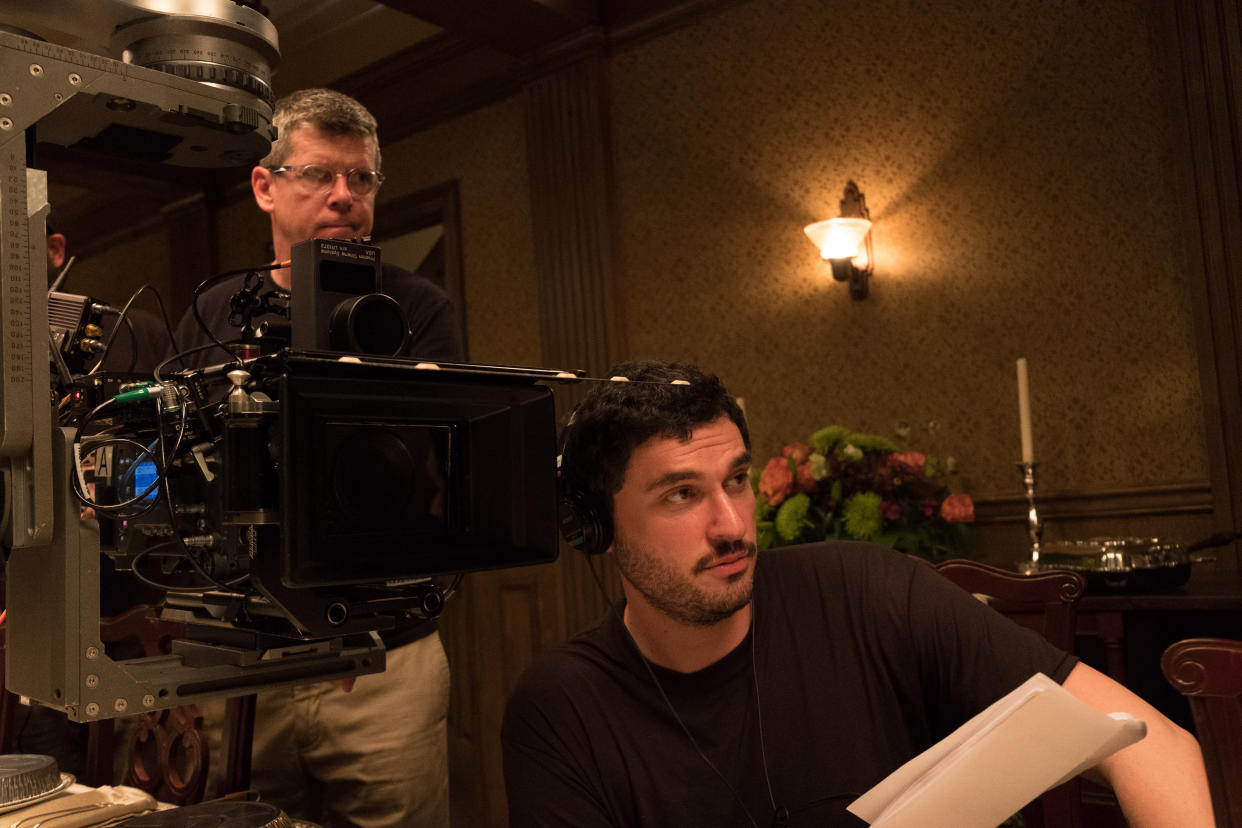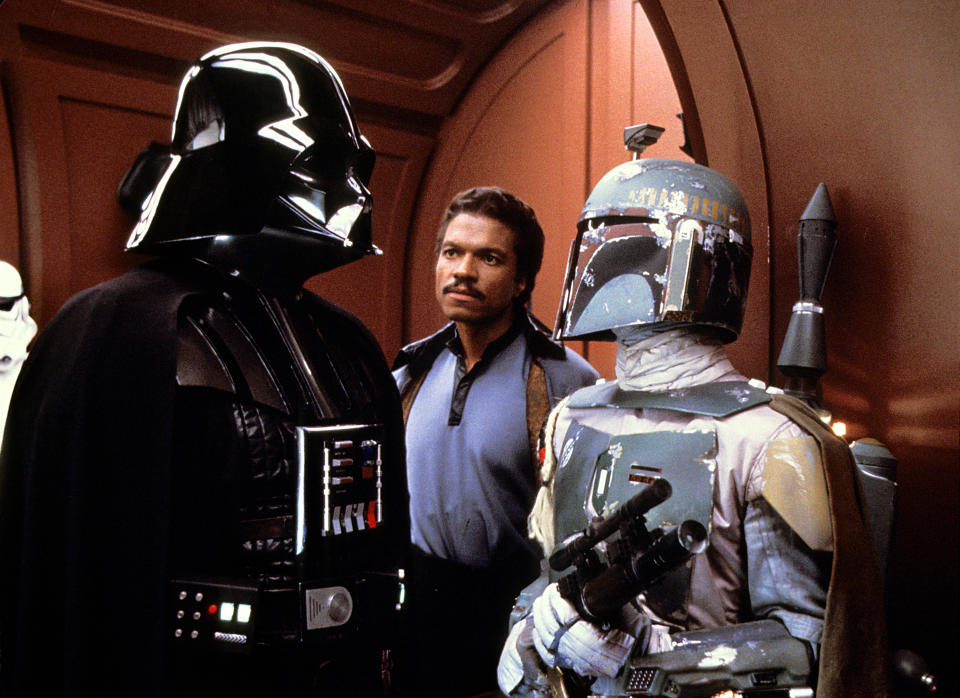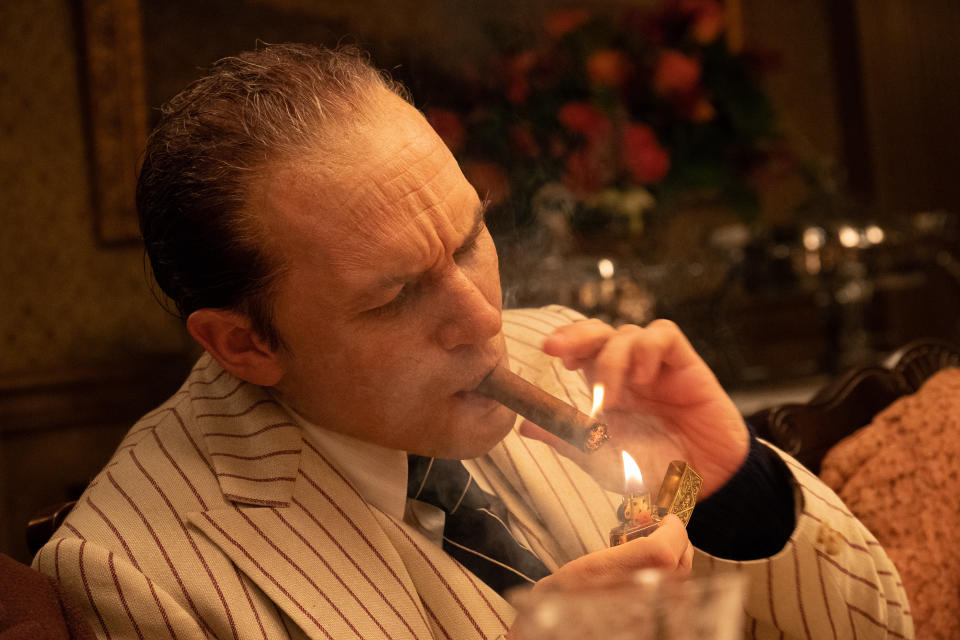'Capone' director Josh Trank shares details on 'Star Wars' spinoff movie that never was, pivotal 'Fantastic Four' meeting with Stan Lee

Five years ago, Josh Trank found his once-promising directing career all but destroyed following what he describes to Yahoo Entertainment as “my own personal sort of nuclear bomb situation.” That’s a cheekily apocalyptic reference to Fantastic Four, his ill-fated 2015 cinematic reboot of Marvel Comics’s first family starring Miles Teller, Kate Mara, Michael B. Jordan and Jamie Bell. Much has already been written about the movie’s troubled production, which culminated in 20th Century Fox removing Trank — who rocketed to the industry’s A-list after making the surprise 2012 hit, Chronicle — from extensive reshoots as well as the editing room as reports of his on-set behavior circulated in the press.
“I spent a good many months just feeling very trapped in this conflict with my own self identity, which was born from reading these very, very in-depth articles that were written by people who I'd never met in my life, all based off of testimony from sources that were not named,” Trank says on the cusp of releasing his comeback film, Capone, starring Tom Hardy as the legendary 1920s gangster. (Vertical Entertainment is releasing the film on digital streaming services starting May 12.) “And the stories painted a picture of this person, Josh Trank, who is inept and in over his head and causing all this damage and in conflict with all these people, and that’s not what my experience was inside of me.”
Within Hollywood, the stories were convincing enough to cost Trank some high-profile directing jobs, most notably a standalone Star Wars film starring everyone’s favorite Han Solo-hunting mercenary, Boba Fett. The movie was originally announced in 2014 as part of the now-defunct A Star Wars Adventure series that also produced Rogue One and Solo. By May 2015, though, Trank parted ways with Disney and Lucasfilm. Citing NDAs, he declines to discuss the specifics of what his Boba Fett film might have been — like whether it was a prequel to the original trilogy or a film that picks up after the bounty hunter’s apparent death in Return of the Jedi.

“Out of respect to the people working there now, I don’t want to blow their cover. They’re all working very hard on Boba Fett and the Star Wars universe.” (For the record, it appears that Fett will have a role in Season 2 of the Disney+ series, The Mandalorian, which takes place after the events of Jedi. Temuera Morrison will reportedly be under Boba Fett’s Mandalorian helmet, having previously played his clone “father,” Jango Fett, in 2002’s Star Wars: Episode II — Attack of the Clones.) When asked what drew him to Boba Fett in the first place, though, Trank’s response offers a possible vision for his never-made movie.
“One of my all-time favorite movies, which I've seen a billion times, is Unforgiven,” he says, with obvious reverence. “I'm a massive fan of Clint Eastwood's filmography and the arc of his characters as a gunslinger — specifically in the Sergio Leone films — obviously had a huge influence on sort of the look and demeanor of Boba Fett. If you look at Star Wars in general, all of the characters from the original trilogy by George Lucas are these archetypes of big cinematic characters that have existed for a long time, so there was a lot there that I was very drawn to.”
When Fantastic Four finally limped into theaters in August 2015, it was met with swift derision by critics, as well as comic fans and even Trank himself, who tweeted on the film’s opening weekend: “A year ago I had a fantastic version of this. And it would have received great reviews. You’ll probably never see it. That’s reality though.” The director’s assessment of the film has improved, slightly, with time. “The movie is alright,” Trank wrote on Letterboxd last November. “I was expecting it to be much worse than it was. I literally haven’t seen it since like two weeks before it came out, and I was in a heavily f***ing traumatized state of mind.”
While the behind-the-scenes problems are readily visible in the finished film, there’s at least one way that Trank’s Fantastic Four broke the mold for comic book movies at the time: his decision to cast Jordan — who also starred in Chronicle — as Johnny Storm a.k.a. the Human Torch. That casting choice inspired backlash from certain segments of fandom, who took to the internet to express their displeasure at a black actor playing a role that had traditionally been drawn as a white character. But Trank and Jordan stood firm, bolstered by the knowledge that they had the full support of Johnny’s creator, Stan Lee. The director’s first meeting with the Marvel Comics icon, who died in 2018, remains a cherished memory of his otherwise troubled Fantastic Four saga.

“I met with Stan at his office in Beverly Hills,” Trank remembers. “One of the items on my agenda was to ask him about this bit of casting, which obviously would change the character. He had seen Chronicle and loved it, and that was a good segue for me to ask, ‘What do you think of Michael B. Jordan as Johnny Storm?’ He looked at me without missing a beat and said, ‘That sounds terrific.’ I said, ‘I think Michael B. Jordan is the best actor for this character, but I can see that there might be backlash from certain fans.’ And he said to me: ‘Who cares about what they have to say? That’s really inspired casting — I love it.’”
“That’s why Stan’s an icon,” Trank continues. “He was a timeless figure of inclusiveness and open-mindedness, and it’s nice to see that his legacy has inspired others to think the same way.” Asked if he had planned to have Lee make one of his trademark cameos in Fantastic Four, Trank says the cameo fell by the wayside as his relationship with the studio soured. “We had it written into the script… and the plan was to pick that up later because we were going to be doing additional photography. But that was before things changed very drastically once I showed the studio my cut.”
Five years after Fantastic Four, the legacy of Lee’s push for inclusiveness can be seen in many cinematic superhero universes. The 2018 blockbuster, Aquaman, features bi-racial star, Jason Momoa, as DC’s aquatic superhero, while Sony’s burgeoning Spider-Verse kicked off with the first big-screen appearance by Miles Morales. And within the Marvel Cinematic Universe, characters like Flash Thompson and Valkyrie are played by actors who don’t resemble their traditional comic book counterparts.
“Stan was exhilarated by the idea of it,” Trank says. “After our meeting, he followed up with me in an e-mail, referring to Michael as ‘The mighty Michael B. Jordan.’ I have some really kind e-mails with Stan Lee that every now and then I'll look back at, and they just bring a tear to my eye. Regardless of the fact that I ultimately presided over a cinematic outing that did not contribute positively to the legacy of those characters, that’s not something that bothered Stan Lee. He was like, ‘Keep your chin up, kid. Never give up: I loved Chronicle and I believe in you.’”
Lee’s words no doubt echoed in Trank’s head as he sought to put his life and career back together in the wake of Fantastic Four. “I was just kind of left to this sudden eerie silence of my phone not ringing and not hearing from anybody,” he remembers now. That sense of profound isolation proved the starting point for Fonzo, the script that eventually became Capone. The film isn’t about the larger-than-life version of Al Capone movie lovers might remember from gangster films like The St. Valentine’s Day Massacre or The Untouchables. Set in the final months of his life in 1947, this Capone is a former master of the universe brought low by personal failings, as well as public rejection following his 1931 conviction on tax evasion and subsequent eight-year imprisonment.

Holed up in his Florida estate, he’s attended to by a dwindling number of family members and friends — not unlike the last act of the Orson Welles classic, Citizen Kane, where the title character spends his final years in near-total isolation in his stately Gulf Coast pleasure-dome, Xanadu. “There was definitely a deep connection between that film and the way that I perceived Capone in his own Xanadu on Palm Island,” Trank confirms. “I was about 12 years old the first time I saw Citizen Kane, and it’s a movie I stand in awe of and connect to on a personal level. There was a subconscious influence as I was writing Capone: Here’s this man who has always looked at the world in this Napoleonic conquest type of way sitting out there with a cigar in his mouth, reflecting on this huge life that is now been reduced to this eerie silence. He’s a ghost, so to speak.”
Besides Kane, there’s also a real-world analogue for Capone who found his way into Trank’s script as he developed the drama over a three-year period, from 2015 to 2018. “I started writing the film in the fall of 2015, when Donald Trump had started campaigning for president,” the writer/director explains. “At first, it was like, ‘This is hilarious.’ Until it became not hilarious and instead became very serious. Once he won, I was deep into prep on the movie, and I kept thinking that there was definitely an interesting parallel. The same conditions that allowed somebody like Donald Trump to become president are, on some level, the same conditions that allowed somebody like Al Capone to take advantage of the bootlegging black market. It’s the story of America — the best and the worst of us.”
Indeed, since President Trump’s own lush refuge, Mar-a-Lago, is also located in Florida, some viewers may see Trank’s recreation of Capone’s past possibly foreshadowing Trump’s post-Oval Office future. “It’s this intimate view of a man who is so iconic in his time period, but in a time when no one really wants to hear from him anymore,” Trank agrees. “The only difference between Donald Trump in the future, and what Al Capone experienced in Palm Island is that Trump will always have Twitter! Unless they ban him from Twitter, which I could weirdly see that happening once he's out of office — however that works out.”
Hardy’s performance ultimately owes less to Trump or to Welles than it does to... Bugs Bunny. “There’s definitely some Bugs in there,” Trank says of the distinctive vocal pattern that the actor (who is no stranger to strange voices) adopted to play Capone. “Mel Blanc used a Brooklyn accent, and we also researched people who would have been in the same neighborhoods as Capone, whose voice we also had on record. I landed on [singer] Jimmy Durante and sent Tom a lot of Durante recordings, and Tom would send me his voice notes. We had a lot of fun with that.”

Hardy also took great delight in undergoing yet another extreme physical makeover to play Capone. When photos of his appearance hit the internet two years ago, fans were taken aback by his dramatic weight gain and pockmarked face. And Hardy’s performance in the finished film is entirely free of movie star-vanity, from his perpetually bloodshot eyes to literally explosive bowels. Trank credits Hardy’s regular make-up collaborator, Audrey Doyle, with helping his star create an Al Capone that audiences won’t easily forget.
“We spent two days in the make-up room experimenting with different looks and different levels of aging, as well as the degrees of syphilitic damage to his skin,” he remembers. [The real Capone lived with syphilis for much of his life.] And if Trank felt any fear about alienating audiences with his leading man’s appearance, he didn’t let that creep into the room. “I understand that some people might be repulsed or annoyed by it, and that’s perfectly OK. I’m not afraid of how anybody will perceive this version of Capone, because that’s what makes the movie unique.”
When shooting started in March of 2018, Trank unleashed Hardy’s Capone on his first audience: his co-stars. “On the first day of shooting, we just shot Tom chasing kids outside to break the ice for everybody to be like ‘Here’s Tom Hardy in this crazy get-up.’ And then on the second day, we shot a Thanksgiving dinner scene, and that was the first time that anybody heard Tom's voice. It was amazing.”
That scheduling arrangement also allowed the rest of the cast — which includes Linda Cardellini as Capone’s wife, Mae, Noel Fisher as his son and Matt Dillon as a fellow mobster — to meet Hardy at his particular level of crazy. “We had an agreement with each other that it’s OK to fail, and there’s no such thing as humiliating yourself,” Trank says. “To be crazy is OK. We tried all of these different levels of intensity with Tom and the actors in the room, and then once we found that tone it was just incredible. That’s why people want to work with him: His drive to counter any movie star perceptions is liberating.”
Capone is currently available to rent or purchase on most digital services, including Amazon and iTunes.
Read more from Yahoo Entertainment:

